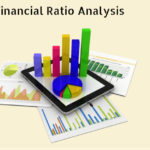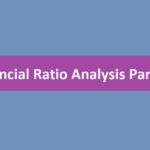Cash Flow Statement Summary
A company’s cash flow statement is a very important financial statement. This shows how much cash/cash the company is earning. You may ask whether this information is not included in the P&L statement, the answer is yes or no.
Let us consider the example of a coffee shop, where the transaction is in cash. If you want coffee or something to eat, you must have that much money. Suppose one day coffee worth Rs 2500 and food items worth Rs 3000 were sold in this coffee shop.
This means that the company earned ₹ 5500 on that day. This ₹ 5500 will show up as income in the company’s P&L. There will be no room for doubt in this.
Now let’s take another example suppose there is a shop which sells laptops. Let’s assume that only one type of laptop is sold at this shop, which costs ₹ 25000. Suppose 20 laptops were sold at this shop on any one day i.e. a total of ₹ 500000 was earned, but what would happen if five of these laptops were sold on credit?
Selling on credit means that the customer takes the goods to his home and pays the money later in a lump sum or in installments. What will this sales figure look like now?
Sales in cash : 15 × 25000 = Rs 375,000
Credit Sales : 5 × 25000 = Rs.125,000
Total Sales: Rs.500,000
In the P&L statement of this shop, you will see the total earning of ₹ 500,000, which is good to see. But how much of these ₹ 500,000 will be cash in the company’s bank account, it is not clear if the company has a loan of ₹ 400,000, which it has to pay immediately. The company will not be able to do so as it has only ₹375,000 in its bank account although it has sold ₹500,000. This means that the company will not be able to meet its liabilities as it does not have enough cash.
Such information is found only in the cash flow statement. That is why the cash flow statement of the company is considered important and it should be seen carefully as a financial statement of any company because only then you will know the cash or cash position of the company.
Keep in mind that the financial condition of the company is not only known by its profits but also it has to be seen that how much cash or cash the company has and how is the cash flow of the company? This is a better way to know the condition of the company.
Activities of the Company
Before we understand the cash flow further, it is important to know what kind of things happen in the functioning of the company. If you think carefully, you will see that the business of the company can be divided into three main parts. Let us understand with an example
Suppose there is a company that runs a fitness center. What do you think is the work done there. I make a list of its work.
- Advertising to attract new customers
- Hiring a Fitness Trainer to Serve Clients
- Replacement of old machines with new fitness machines
- Taking short term loan from bank for this purpose
and issue certain certificates of deposit to raise money - Issue more shares to some friends to raise money
- Investing in some new startup companies trying to bring new innovations
- Keeping the balance in a fixed deposit
- investing money in a building in a new area so that a fitness center can be opened there
and installing a new sound system in the fitness center
You can see that all this is related to his business. But these are very different things.
We can divide them into three parts:
Operational activities/ OA: This is the work that is related to the main business or business of every day. This is called operational activity. It includes sales i.e. sales, marketing, manufacturing i.e. production, technology, and resource hiring i.e. employing people or machines etc.
Investing activities/ IA: It includes the work that the company does with the intention that it will get benefit from it later. Like investing to earn interest, investing in land or property, investing in machines, intangible assets or non-current assets.
Financing activities /FA: This includes activities that a company does financially such as distributing dividends, paying interest on loans, raising new debt or issuing corporate bonds.
The functioning of any good company can be divided into these three parts.
On the basis of these three parts, we divide the functioning of the company mentioned earlier.
- Advertisement to attract new customers OA
- Hiring a Fitness Trainer to Serve Clients OA
- Replacement of old machines with new fitness machines OA
- Taking short term loan from bank for this purpose FA
and issue some certificate of deposit to raise money FA - Issue more shares to some friends to raise money FA
- Investing in some new startup companies trying to bring new innovations IA
- Keeping the remaining money in a fixed deposit IA
- Investing money in a building in a new area so that a fitness center can be opened there IA
and installing a new sound system in the fitness center OA
Now think that whatever work the company is doing will affect the cash position of the company because either cash will be coming out or cash will be coming in. Whatever the company does, it definitely has an impact on the cash/cash position. For example, if the company wants to buy sound equipment, then for this the company will have to pay money and its cash position or cash balance will be less. Also, this sound system will act as an asset to the company.
In this perspective, let us now revisit the above example and understand how each action affects the cash balance and balance sheet.
| No. | Type of activity | Need | Cash Balance | In Balance Sheet |
| 01 | OA | Advertisement Expenses | will reduce | Is an asset, enhances the brand value of the company |
| 02 | OA | cost of hiring new people | reduce | Is an asset, enhances the intellectual value of the company |
| 03 | OA | Cost of new machines | reduce | An asset |
| 04 | FA | Debt means cash will come in business | will grow | debt ie liability |
| 05 | FA | Deposit through CD means cash will come | will grow | CD /liability |
| 06 | FA | Issuance of new capital will bring cash | will grow | Increase in share capital means liability |
| 07 | IA | Cash will go by investing money in startup companies | reduce | Investment is an asset |
| 08 | IA | Cash will go by putting money in FD | reduce | Cash is the same investment so is an asset |
| 09 | IA | Investment in building will mean cash from business | reduce | Gross Block is an asset |
| 10 | OA | cost of sound system | reduce | is an asset |
We have color-coded it in the table above:
- Cash increase means blue color
- Decreased cash means red color
- green color for asset
- adding liability means purple color
If you look at the above table in terms of the relationship between cash balance and asset/liability, you will find that:
Whenever the company’s liability increases, the company’s cash balance also increases.
This also means that when the company incurs any liability, the cash balance also decreases.
Whenever the company’s assets increase, the cash balance decreases
As assets decrease, cash balance increases
These findings are the most important principles for making a cash flow statement. It is also to be noted that every activity of the company, whether it is operating activity, finance activity or investing activity, either increases or decreases the cash of the company.
In this way, now the cash flow of the company will be added like this.
Company’s Cash Flow = Net Cash Flow of Operating Activity + Net Cash Flow of Investing Activity + Net Cash Flow of Financing Activity
Cash Flow Statement
After knowing these important things about cash flow statement, now you will be able to understand cash flow statement in a better way.
When any company prepares its cash flow statement, then that statement is divided into three parts. So that it can be clearly seen how much cash the company made or spent within the three operations mentioned above. Based on this, we now turn to the Cash Flow Statement of ARBL.

I have omitted several line items here because there is no need to explain them. But note here that ARBL has raised 278.7 crores from operating activity. One thing to remember is that if any company has positive cash flow from its core business i.e. operating activities, it shows that the company is doing well.
Here you can view the Cash Flow from the Operating Activity of ARBL.

As you can see that ARBL has spent Rs 344.8 crore in investing activity. You must have understood that due to this the company has less cash. At the same time, it is also worth noting that if the company is making good investments, it means that the company wants to grow its business going forward. But whether the company has made good investment or bad, we will understand further.
Now let’s look at the cash balance of ARBL’s financing activity.
You can see that ARBL has spent Rs 53.1 crore under the financing activity. Most of this cash has been used to pay dividends. If the company takes more debt in the future, it will result in an increase in the cash balance with the company (cash balance increases as the liability increases). But we know from the balance sheet of ARBL that the company has not taken any fresh debt.
Let’s look at the cash flow statement once under all three activities.
| whose cash flow | Crore Rs (2013-14) | Crore Rs (2012-13) |
| Operating Activities | 278.7 | 335.4 |
| Investing Activities | (344.8) | (120.05) |
| Financing Activities | (53.1) | (34.96) |
| Total | (119.19) | 179.986 |
This means the company has spent Rs 119.19 crore in the financial year 2013-14. But what happened to last year’s cash? As you can see the company generated cash of Rs.179.986 crores last year. Let us once again look at the cash flow statement of ARBL.
Look at the part highlighted in green. Here it is mentioned that the opening balance of this year (2013-14) is Rs 409.46 crore, where did this amount come from? This is actually the closing balance of the previous year (shown by arrow). In this, when this year’s cash figure is added which is 119.19 crores and foreign exchange’s 2.58 crores is added to this, we get the total cash position of the company which is 292.86 crores. This shows that the company has spent a lot of cash annually, but despite this, the company has a lot of cash due to the last year’s cash.
Remember that the closing balance of 2013-14 will now be the opening balance of 2014-15. When you look at the ARBL figures as of March 31, 2015, you should see this amount.
Now let us look at some questions and their answers.
Q. What does the figure of Rs 292.8.6 crore indicate?
- It tells how much cash is currently kept with ARBL in the company’s bank account.
Q. What is Cash?
- It means the cash which is with the company or which is kept in demand deposit. These are the liquid assets of the company.
Q. What are Liquid Assets?
- These are assets that can be easily converted into cash or cash-like things.
Q. Can we treat liquid assets as current items, which are shown in the balance sheet?
- You can treat these as current items.
Q. If cash is current and cash is an asset, should it be shown under current assets in the balance sheet?
- Correct. This is a current asset and it shows up there. Let’s take a look at the balance sheet.
 From this, we can conclude that there is a relationship between the cash flow statement and the balance sheet. We discussed earlier that all three financial statements are interlinked.
From this, we can conclude that there is a relationship between the cash flow statement and the balance sheet. We discussed earlier that all three financial statements are interlinked.
Financial Statements Briefly
In the last few chapters we have discussed 3 most important financial statements of a company namely P&L Statement, Balance Sheet and Cash Flow Statement. Cash flow statement and P&L statement are prepared in standalone manner whereas balance sheet is prepared in flow manner.
How much the company earned, how much it earned, and how much it spent is discussed in the P&L statement. Out of the company’s income, the money that is left after spending (surplus or retained income) is carried forward by the company in its balance sheet. The P&L statement also contains the company’s depreciation figures and the depreciation figures are carried forward from the P&L statement to the balance sheet.
The balance sheet shows the assets and liabilities of the company. Company Shareholders Fund is also shown in the assets section of the balance sheet. The asset should always be equal to the liability, only then the balance sheet is considered balanced. An important piece of information in any balance sheet is how much cash or cash equivalents the company has. This shows how much money is in the company’s bank account. This figure comes from the company’s cash flow statement.
Cash flow statement tells about the company’s ability to generate cash or cash equivalents. Also, it is also told how much cash the company will need. In this, old historical data is also taken. This means that the figures of the previous year are also included in this and all the information about the cash or cash equivalent is given from the point of view of operating, investing and financing activity. It is also told how much money is currently in the company’s bank account.
So far we have learned how to read a company’s financial statements, what information they contain and what we should look for in them. But we haven’t learned yet how to analyze these data? One way to analyze these is to look at some important financial ratios. We will look at the financial ratio in the next few chapters.
Highlights of this chapter
- Cash Flow Statement gives us information about the cash position of the company
- The functioning of any good company can be divided into three parts- Operating Activities (Business Functions), Investing Activities (Investment Functions), Financing Activities (Financial Functions).
Money is spent or money is earned from any kind of work. - A company’s net cash flow is made up of the cash flows from all three operations, operating, investing and financing.
- Any investor should carefully look at the operating activity of the company i.e. cash flow of business operations.
- When the company’s liability increases, the cash increases and if the liability decreases, the cash decreases.
- As assets increase, cash decreases, as assets decrease, cash increases.
- You can also see the company’s net cash flow in the balance sheet.
- Cash flow statement is a financial statement showing the true state of business of a company.

Gaurav Heera is a leading stock market educator, offering the best stock market courses in Delhi. With expertise in trading, options, and technical analysis, he provides practical, hands-on training to help students master the markets. His real-world strategies and sessions make him the top choice for aspiring traders and investors.





